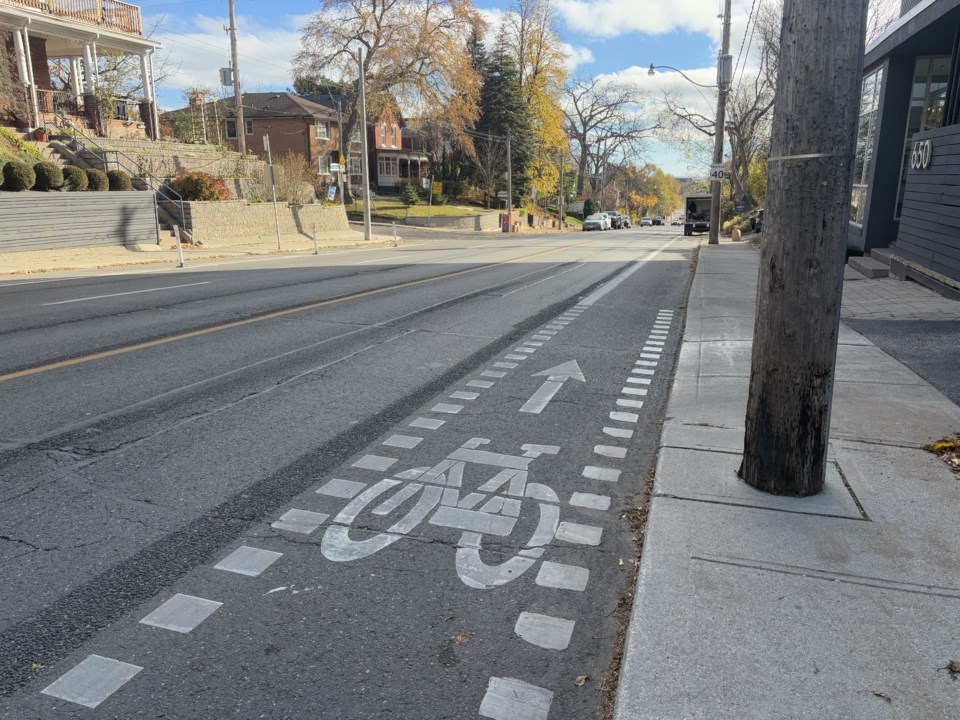Toronto city council is moving forward with a plan to create a street sweeping protocol to ensure bike lanes are clear of debris during construction projects in the downtown area.
The plan comes after Coun. Paula Fletcher slammed the “filthy” and “dangerous” bike lanes in her ward, Toronto-Danforth. Metrolinx construction of the Ontario Line this summer left a mess on Dundas Street East, creating a safety hazard for cyclists, she said during a July community council meeting.
The motion to create a bike lane maintenance plan around construction zones was adopted unanimously without debate at Wednesday’s city council meeting.
The “street sweeping service standard,” as City Hall calls it, will be created by the deputy city manager of infrastructure services, Will Johnston.
He has been directed to present the plan to the Toronto and East York Community Council on Feb. 20, 2025.
This bike lane maintenance protocol only applies to Toronto’s downtown wards, extending from High Park to the Beaches as far north as Davenport (Wards 4, 9, 10, 11, 12, 13, 14 and 19).
Johnston has been directed to create a maintenance plan for both separated and non-separated bike lanes, including routine inspections as well as complaint-based inspections, for bike lanes near construction zones.
The plan is set to include enforcement measures if bike lanes are not kept clean, though these measures have not yet been announced.
Cycle Toronto, a cycling advocacy group, has supported the efforts of City Hall to keep bike lanes clean.
“This isn’t about convenience. It’s about safety,” wrote Executive Director Michael Longfield in a letter to the City Council.
Ensuring bike lanes are clear and well-maintained is “essential” for protecting the safety and “comfortable passage of the growing number of people who cycle in Toronto,” he wrote.
Longfield also raised the issue of a cyclist who was killed this summer after a large garbage disposal bin was left on Bloor Street, blocking a bike lane and forcing a 24-year-old cyclist to merge into the vehicle lane. She was struck and killed by a large commercial vehicle and died at the scene.
The city laid bylaw charges against two companies, Ontario Trucking and Disposal Ltd. and Mass Contracting Ltd., who were involved in the incident.
Longfield said the city’s plans for bike lane maintenance must ensure “bikeways are safe and passable to avoid another tragedy.”
Cyclist killed on Bloor just east of Avenue. Perhaps she was riding outside the bike lane anticipating having to go around a construction bin blocking the curb lane just before the intersection pic.twitter.com/qrujYIlSsC
— jnyyz 🚲 (@jnyyz) July 25, 2024
Coun. Dianne Saxe has also been a vocal supporter of the bike lane maintenance plan. She said a cyclist in her ward, University-Rosedale, was injured after gravel was left behind in a bike lane during construction.
“I reported it, and reported it, and reported it and nothing happened until the woman was injured,” Saxe said during the July Toronto and East York Community Council meeting.
Dirty bike lanes are “a consistent problem across the city,” she said.
As it generally stands now, it is the responsibility of the construction company to ensure sidewalks, bike lanes and motorways remain clear of debris, according to a report prepared for the community council. This is true for private construction projects, city contractors and transit-related construction undertaken by Metrolinx.
The City of Toronto is responsible for sweeping bike lanes outside of construction zones.
Currently, Solid Waste Management Services said it sweeps separated bike lanes at least once per week but some separated routes are swept more frequently on an as-needed basis.
For bike lanes that aren’t separated from the roadway, Transportation Services reported it sweeps the bike path at the same time the road is serviced. Major roads are swept at least once per month or more, as needed.
Local residential streets get swept once a season in spring, summer and fall.
Transportation Services does not have a dedicated protocol for bike lane sweeping. The department is completing a review of its sweeping standards.
